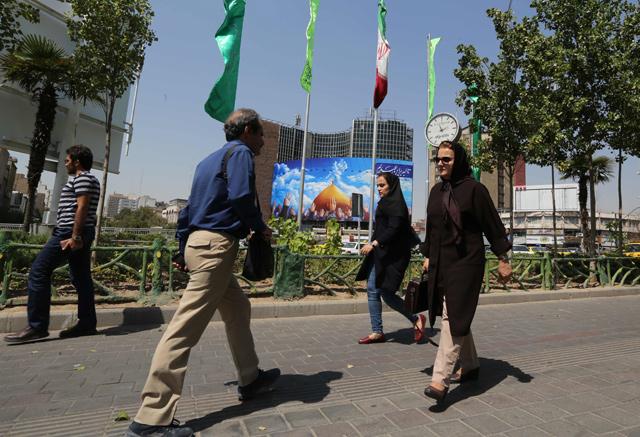You are here
Iran-US relations during Trump presidency
By AFP - Jun 25,2019 - Last updated at Jun 25,2019

An Iranian woman walks past a mural painting depicting the late founder of the Islamic Revolution Ayatollah Ruhollah Khomeini (right) and Iran's Supreme Leader Ayatollah Ali Khamenei in the Iranian capital Tehran on Tuesday (AFP photo)
TEHRAN — Long-hostile relations between the United States and Iran saw a thaw under Barack Obama's presidency culminating with the historic nuclear deal struck between world powers and Tehran in 2015.
But since President Donald Trump came to power vowing to undo the hard-won deal, relations have deteriorated once more, with the latest escalation coming after Iran shot down a US spy drone.
Here is a recap of key moments in more than two tumultuous years:
‘Isolate’ Iran
In a landmark address to Middle Eastern leaders in Saudi Arabia, on May 21, 2017, Trump urged nations to work together to isolate Iran "until the Iranian regime is willing to be a partner for peace".
"From Lebanon to Iraq to Yemen, Iran funds, arms and trains terrorists, militias and other extremist groups that spread destruction and chaos across the region."
The Iranian government, Trump charged as he addressed the United Nations on September 19, 2017, "has turned a wealthy country with a rich history and culture into an economically depleted rogue state whose chief exports are violence bloodshed and chaos".
Nuclear deal walkout
Trump on May 8, 2018 pulls the United States out of the nuclear pact between world powers and Iran, calling it "defective at its core".
The move heralds the reinstatement of US sanctions on Iran and companies with ties to it.
Washington warns other countries to end trade and investment in Iran and stop buying its oil, or face punitive measures.
On August 7, Washington reimposes a first set of sanctions that involve freezing financial transactions and imports of raw materials, and penalties on purchases in the car and commercial aviation sectors.
A second wave of US sanctions comes into force on November 5, described by Washington as the "toughest" yet.
‘Terrorist’
On April 8, 2019, the US designates Iran's elite military force, the Islamic Revolutionary Guard Corps, a terrorist organisation.
The Guards' prized Quds Force, which operates abroad, is also placed on the blacklist.
In response, Iran declares the United States a "state sponsor of terrorism" and its forces in the region "terror groups".
End of waivers
On April 22, 2019 Trump announces the end of exemptions that had allowed eight countries to purchase Iranian oil without breaching unilateral US sanctions.
Two weeks later, on May 8, Iran says it has decided to suspend some of its commitments under the nuclear deal, some immediately and some after 60 days if no progress is made on sanctions relief.
They include restrictions on the level to which Iran can enrich uranium and modifications to the Arak heavy water reactor designed to prevent the production of plutonium as a byproduct.
Trump announces new measures against Iran's steel and mining sectors.
US drone shot down
On May 12, two Saudi oil tankers and two other ships are damaged in mysterious "sabotage attacks" in Emirati waters. Washington and Riyadh blame Iran.
In early May, Washington deploys additional troops to the Middle East, accusing Iran of planning "imminent" attacks on US interests.
On June 13, two tankers come under attack in the Gulf of Oman. Trump says the incident has Iran "written all over it" while Tehran denies involvement.
On June 20, 2019 Iran's revolutionary guard shoots down a US "spy drone" which violated Iranian airspace near the Strait of Hormuz. The Pentagon denies the drone entered Iranian airspace.
The next day Trump says the US was "cocked & loaded" to strike Iran in retaliation, but pulled back because it would not have been a "proportionate" response.
Sanctions against supreme leader
On June 24, 2019, the United States imposes sanctions targeting Iran's Supreme Leader Ayatollah Ali Khamenei and senior military leaders of the Islamic republic.
The US Treasury says it is targeting eight top commanders from Iran's elite military force, the Revolutionary Guards and would also blacklist Iran's Foreign Minister Mohammad Javad Zarif — a moderate figure and key architect of the 2015 Iran nuclear deal — targeting billions of dollars in assets in all.
Related Articles
Iran's elite Revolutionary Guards said Sunday its forces shot down an Israeli drone as it approached an Iranian nuclear site, recovering major parts of what it described as an advanced aircraft. Israeli officials could not be immediately reached for comment.
TEHRAN — Relations between Tehran and Washington have spiralled since US President Donald Trump came to power and promptly quit the internat
ANKARA — The chief of Iran's elite Revolutionary Guard Corps said on Thursday that Tehran's missile attack on an Iranian Kurdish rebel base

















